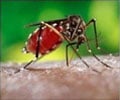Using two experimental anti-malarial vaccines, which work in different ways, can greatly reduce the number of malaria infections in animal studies.

‘Using two experimental anti-malarial vaccines, which work in different ways, can greatly reduce the number of malaria infections in animal studies.’





"Reaching a potential 91% reduction in cases would have a huge impact on public health because the vaccines could be effective in areas where malaria is more prevalent." Malaria is caused by a group of parasites that have a complex life cycle, spending time in the mosquito midgut and salivary glands, in the human liver, and circulating in human blood, where they cause the disease.
The team tested two types of vaccines: those that prevent mosquitoes from transferring the parasites, called transmission-blocking vaccines (TBVs), and those that prevent the parasite from infecting the liver, termed pre-erythrocytic vaccines (PEVs).
RTS,S is the world's first PEV malaria vaccine that has been shown to provide partial protection against malaria in young children by blocking infection of the liver. However, its maximum efficacy is under 50% (i.e. it reduces cases by around 50%).
There are currently several types of transmission-blocking vaccines in early trials, which are thought to reduce the number of parasites in the mosquito salivary glands. Their efficacy typically ranges from around 50-95%.
Advertisement
The team also found that combining any of the two types of vaccines improved efficacy of the mixture more than might be expected from the single efficacy of each vaccine separately.
Advertisement
The team will next study how combined vaccines could work in more complex situations. Dr Blagborough said: "In the real world, the vaccine coverage we can achieve- how many people we can give it to - is important, as are the local levels of transmission, and how prevalent malaria currently is in that area.
"We plan to use a combination of rodent experiments and computer modelling to help us estimate effectiveness requirements for future vaccines."
The efficacy of current lead malaria vaccines is known to reduce over time after vaccines are administered, so the team will also investigate how combined vaccines perform in the long term.
Source-Eurekalert












